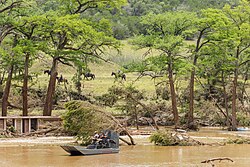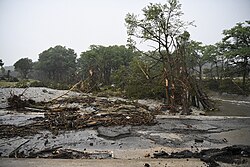$22 Billion Disaster: How the 2025 Texas Hill Country Floods Brought America’s Freight System to Its Knees
- Wakool Transport
- Jul 23
- 7 min read

The July 4, 2025, Texas Hill Country floods have become the deadliest inland flooding event in the U.S. since 1976, claiming 135 lives and inflicting an estimated $22 billion in economic losses. What began as the remnants of Tropical Storm Barry rapidly escalated into a logistics crisis, crippling major freight corridors, grounding over 400 flights at Dallas–Fort Worth International Airport, and prompting the Federal Motor Carrier Safety Administration (FMCSA) to issue emergency relief waivers for the first time since Hurricane Harvey.
The disaster's epicenter in Kerr County witnessed the Guadalupe River surge 26 feet in just 45 minutes, triggering flash floods that overwhelmed infrastructure. Key national freight arteries, I-35 and I-45, were inundated, causing major disruptions to Amazon’s fulfillment networks and forcing widespread emergency rerouting of supply chains across the Southwest. The cascading effects continue to reverberate across national logistics systems, highlighting critical vulnerabilities in inland disaster preparedness.

Executive Summary: Multi-Dimensional Crisis Reshapes Freight Landscape
The July 2025 Texas floods mark a watershed moment for U.S. logistics resilience, with consequences extending well beyond the initial disaster zone. Following the devastation, President Trump issued a Major Disaster Declaration on July 6, activating sweeping federal emergency protocols. Simultaneously, Governor Abbott expanded Texas’s disaster declaration to 26 counties, triggering the state’s largest emergency response deployment since Hurricane Harvey.
To support recovery and supply chain continuity, the Federal Motor Carrier Safety Administration (FMCSA) enacted broad regulatory relief, suspending hours-of-service (HOS) rules for commercial drivers through August 4. This move enables expedited movement of emergency goods, fuel, and essential supplies across affected regions, underscoring the pivotal role of trucking in national disaster response.
Key Logistics Disruptions Include:
400+ flight cancellations and 130+ diversions at Dallas-Fort Worth International Airport
Severe flooding on I-35 and I-45 freight corridors, impacting national truck routing
Amazon's deployment of 68,000+ emergency relief items through its disaster response network
1,750 state personnel and 975 vehicles/equipment units mobilized for recovery operations
Emergency regulatory waivers allowing extended driving hours for relief truckers
The disaster's $18-22 billion economic impact ranks it among the costliest non-hurricane weather events in U.S. history, with supply chain disruptions expected to persist through Q3 2025 as infrastructure rebuilding continues.
Catastrophic Timeline: From Weather Event to Federal Emergency
July 2-4: Flash Flood Genesis
Heavy rainfall from Tropical Storm Barry remnants began saturating Central Texas soil on July 2, with meteorological conditions creating a mesoscale convective complex that stalled over the Hill Country region. By July 4, rainfall totals exceeded 20 inches in isolated areas, with the National Weather Service issuing six flash flood emergency warnings including cities of Kerrville and Mason.
The Guadalupe River's unprecedented surge—rising 26 feet in 45 minutes—created conditions that overwhelmed all existing flood warning systems. The rapid water rise caught Camp Mystic summer camp by surprise, leading to 27 child and counselor fatalities that became the tragedy's most heartbreaking symbol.
July 4-6: State and Federal Response Escalation
Governor Abbott's initial disaster declaration on July 4 covered 15 counties before expanding to 21 counties by July 5. The scope and severity prompted President Trump to approve a Major Disaster Declaration on July 6, triggering FEMA activation and unlocking federal emergency funding streams.
DHS Secretary Kristi Noem's ground assessment with Governor Abbott confirmed the disaster's national significance, with 850 people rescued by Coast Guard helicopters in the first 48 hours alone.
July 7-8: Logistics Industry Emergency Response
FMCSA's emergency declaration on July 7 provided unprecedented regulatory relief for commercial truckers responding to the crisis. The order suspended Parts 390-399 of federal regulations, including hours-of-service limits, inspection requirements, and parking restrictions for vehicles providing "direct assistance to emergency relief efforts."
The death toll crossing 100+ on July 8 marked the disaster's classification as the deadliest inland flooding event since the 1976 Big Thompson River flood, surpassing casualties from Hurricane Helene in 2024.
Transportation Infrastructure Impact Analysis
Aviation Sector Disruption
Dallas-Fort Worth International Airport experienced its most severe weather-related shutdown since 2019, with more than 400 flight cancellations and 130+ diversions during the peak flooding period. American Airlines bore the brunt of disruptions, with ground operations suspended due to lightning strikes and microbursts exceeding 100 mph.
The cascading effect extended beyond Texas, with connecting flight disruptions impacting schedules nationwide. DFW's role as a major cargo hub meant freight delays rippled through express shipping networks, particularly affecting Amazon Prime and FedEx Express time-sensitive deliveries.
Highway Infrastructure Crisis
Interstate 35—America's fourth-busiest freight corridor—experienced multiple closures from San Antonio through Dallas, with lower-level segments in downtown San Antonio completely submerged. The I-35 corridor handles approximately $1.4 billion in daily freight traffic, making these closures economically devastating.
Interstate 45 flooding created vehicle stranding incidents at major intersections, with Fort Worth Fire Department responding to 13 high-water calls in one hour. Emergency routing through alternative corridors increased transit times by 20-35% for freight moving through Texas during the crisis peak.
Supply Chain Resilience Under Extreme Stress
Amazon's Emergency Response Network
Amazon's disaster relief activation within hours of the flooding demonstrates advanced supply chain resilience planning. The company's 15 global disaster relief hubs enabled rapid deployment of 68,000+ essential items, including hygiene kits, gift cards, and emergency supplies to 13 partnered relief organizations.
The technological component proved critical, with Amazon providing search-and-rescue crews with equipment and serving as technology advisors for position mapping and hazard assessment. This integration of private logistics capabilities with public emergency response represents an evolution in disaster management protocols.
Federal Regulatory Innovation
FMCSA's emergency declaration innovation extends regulatory relief to all states on routes to Texas, even those not directly impacted by flooding. This geographic flexibility recognizes modern supply chain complexity, where origin points can be nationwide for disaster relief efforts.
The "direct assistance" requirement specifically excludes routine commercial deliveries and mixed loads with nominal emergency components, preventing regulatory relief abuse while maintaining response effectiveness.
Industry Adaptation and Rerouting
Major trucking companies including ABF Freight, J.B. Hunt, and Saia immediately activated alternative routing protocols, with freight moving through I-10, I-20, and I-40 corridors to bypass flooded Texas routes. Spot market rates increased 15-25% on alternative corridors as capacity tightened due to longer transit times.
Rail freight diversions through BNSF and Union Pacific networks absorbed some truck capacity pressure, with intermodal terminals in Oklahoma and Arkansas reporting 20-30% increased volume during the crisis peak.
Economic Impact Assessment and Recovery Projections
Immediate Economic Devastation
AccuWeather's preliminary $18-22 billion loss estimate encompasses direct property damage, business interruption costs, and supply chain disruption expenses. The Hill Country region's tourism economy—worth approximately $2.8 billion annually—faces extended recovery periods with many outdoor recreation facilities destroyed.
Agricultural losses exceed $800 million, with livestock losses in the thousands and crop destruction across 150,000+ acres of prime Texas farmland. Pecan orchards and vineyards—signature Hill Country industries—suffered permanent tree loss requiring 3-5 year replanting cycles.
Infrastructure Rebuilding Timeline
Texas DOT estimates $2.2 billion in highway infrastructure repairs, with I-35 improvements accelerated due to recurring flood vulnerability. New pump station installations and enhanced drainage systems will reshape flood-prone highway segments over 18-24 months.
Local infrastructure rebuilding across 26 counties includes water treatment facilities, electrical grid hardening, and communications tower replacements. FEMA's Public Assistance program covers emergency work and facility replacement for 13 qualified counties.
Comparative Analysis: Texas Floods vs. Hurricane Harvey
Casualty and Economic Scale
The July 2025 floods surpass Hurricane Harvey's inland impact, with 135 confirmed deaths exceeding Harvey's 68 direct fatalities. However, Harvey's $125 billion total economic impact remains higher due to Houston metropolitan area exposure and petroleum industry shutdowns.
The concentrated nature of Hill Country flooding created higher per-square-mile devastation than Harvey's broader geographic impact, with Kerr County alone accounting for 116 fatalities in a population of just 52,000 residents.
Supply Chain Recovery Comparison
Harvey's supply chain recovery took 90-120 days due to Port of Houston closures and petrochemical industry impacts. The Hill Country disaster's recovery timeline appears shorter for national supply chains but longer for regional Texas networks due to I-35 corridor importance.
Federal regulatory response speed improved significantly, with FMCSA emergency relief issued within 72 hours compared to 5-7 days during Harvey. This institutional learning demonstrates enhanced disaster preparedness protocols.
Industry Adaptation and Future Preparedness
Enhanced Weather Monitoring Integration
The disaster highlighted gaps in flood warning systems for rapid-onset flash flooding scenarios. Texas Legislature's special session beginning July 21 will address early warning system improvements and emergency communication protocols.
Private sector weather monitoring integration with public emergency management emerged as a critical success factor, with Amazon's logistics network providing real-time ground conditions to emergency coordinators.
Supply Chain Resilience Evolution
Multi-modal freight strategies proved essential, with companies maintaining rail backup options experiencing fewer disruptions than truck-only operations. Geographic diversification of fulfillment centers and supplier networks limited exposure for prepared companies.
Emergency logistics protocols developed during COVID-19 disruptions provided institutional knowledge for rapid response activation, demonstrating cumulative resilience building across multiple crisis experiences.
Wakool Transport: Navigating Texas Flood Crisis with Precision Logistics
As the Texas Hill Country confronts unprecedented flooding devastation and $22 billion in economic losses, Wakool Transport delivers comprehensive logistics solutions that keep supply chains resilient when traditional infrastructure fails.
1. Emergency Rerouting and Crisis Response
Real-Time Route Optimization: Our advanced tracking systems automatically reroute freight around flooded I-35 and I-45 corridors, utilizing alternatives to maintain delivery schedules.
Federal Compliance Expertise: Wakool ensures full compliance with FMCSA emergency declarations, maximizing regulatory relief benefits while maintaining safety standards for disaster response shipments.
2. Multi-Modal Crisis Management
Rail-Truck Integration: When highways flood, our BNSF and Union Pacific partnerships provide seamless intermodal transitions, keeping cargo moving through Oklahoma and Arkansas hubs.
Air-Ground Coordination: DFW disruption management through alternative airport utilization and expedited ground transport from Houston, Austin facilities.
3. Disaster Relief and Emergency Supply Chains
Rapid Deployment Capability: 24-hour activation of emergency supply routes, supporting FEMA, Amazon disaster relief, and corporate emergency response initiatives.
Documentation and Tracking: Complete chain of custody and real-time visibility for disaster relief shipments, ensuring accountability and regulatory compliance.
When natural disasters reshape the logistics landscape, Wakool Transport's crisis-tested expertise ensures your supply chain remains operational, compliant, and resilient. Contact us for immediate disaster response coordination and long-term recovery logistics planning.



